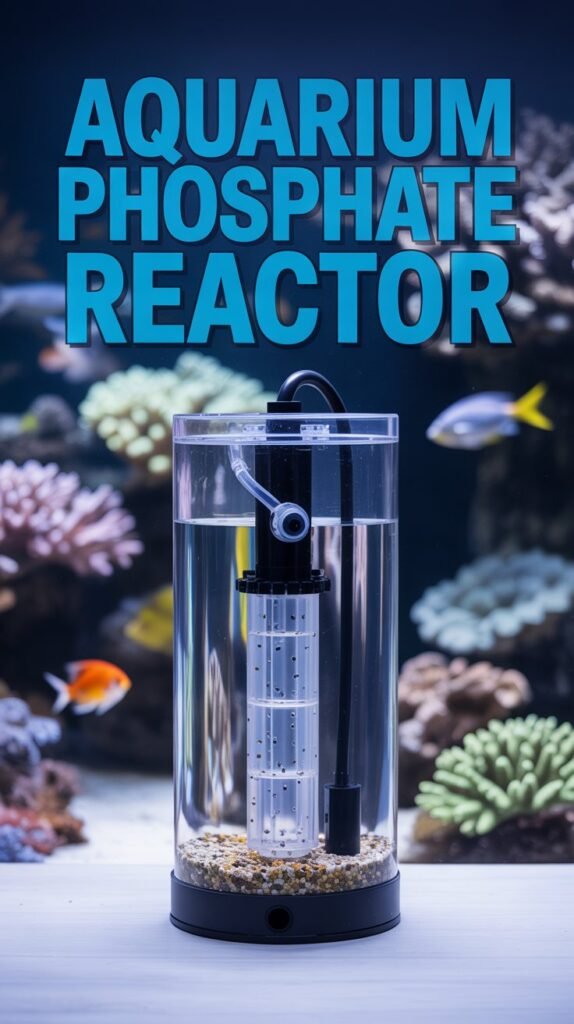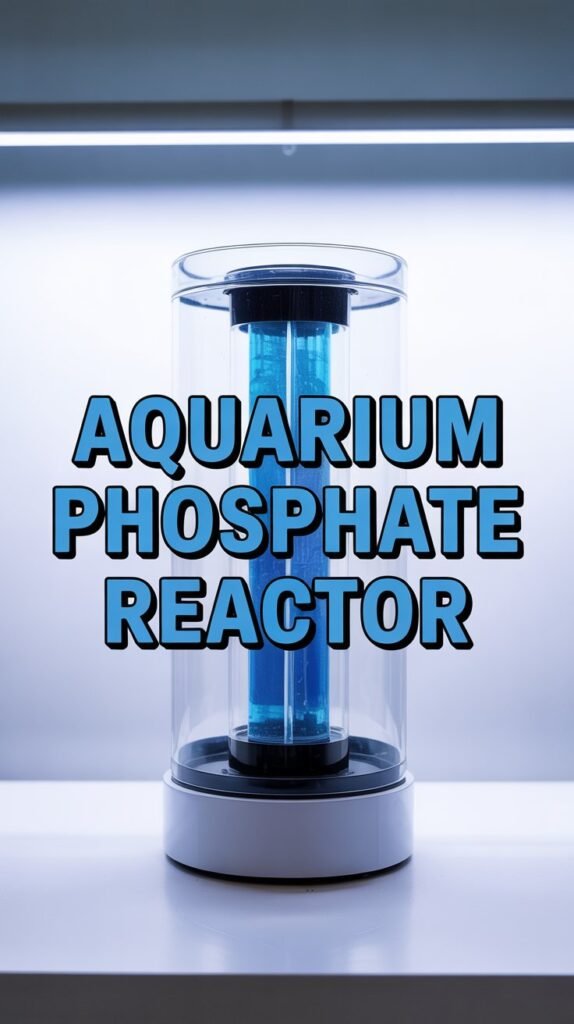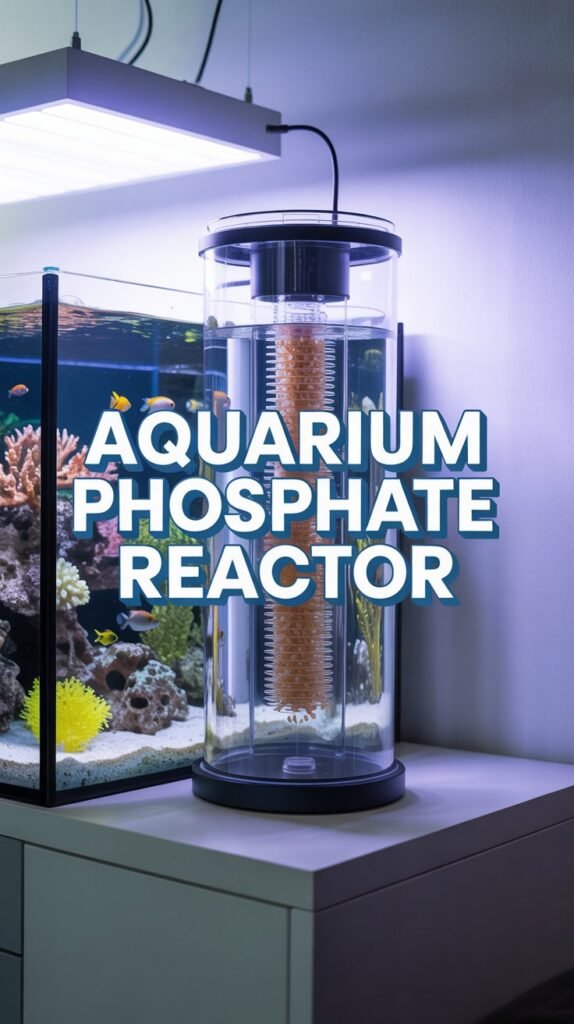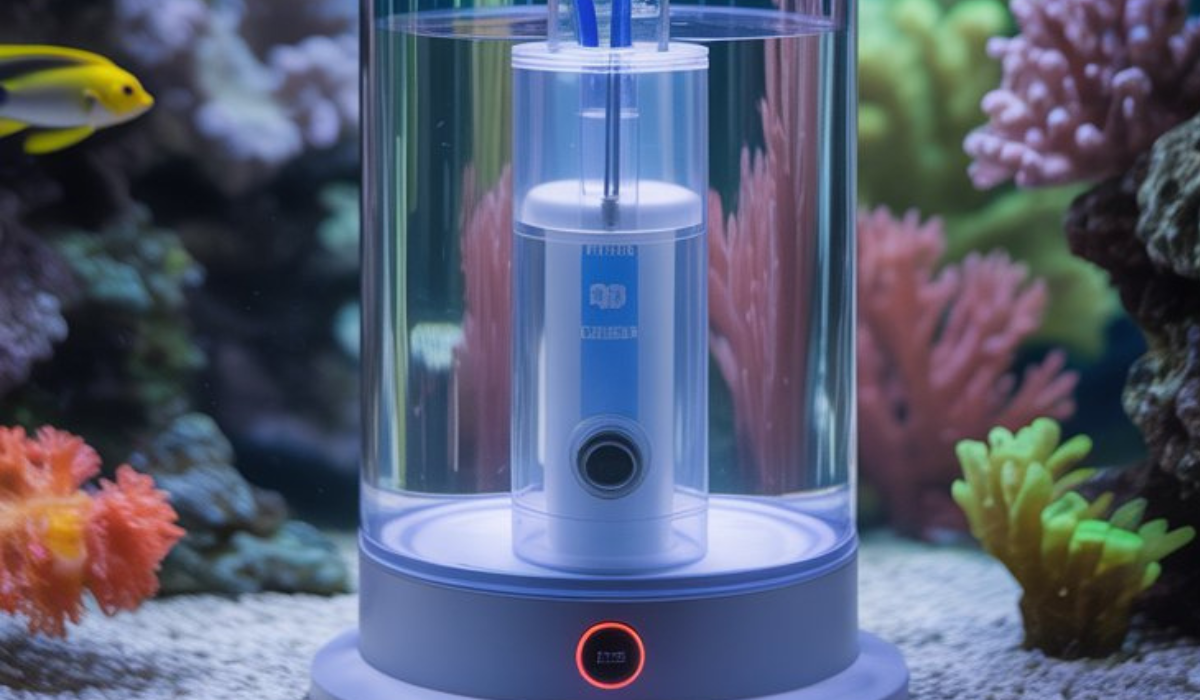Maintaining a healthy and balanced aquarium is every aquarist’s goal, whether you keep a freshwater or marine setup. Among the most common challenges faced by aquarium hobbyists is phosphate control. High phosphate levels can lead to algae blooms, cloudy water, and poor fish and coral health. This is where an aquarium phosphate reactor comes in — a powerful tool that keeps phosphate levels under control and ensures your aquatic environment stays pristine.
In this comprehensive guide, we’ll explore what a phosphate reactor is, how it works, its benefits, installation and maintenance tips, and much more. By the end, you’ll know exactly how to use this device to maintain optimal water quality for your fish, plants, and corals.
What Is a Phosphate Reactor?
An aquarium phosphate reactor is a specialized filtration device designed to remove excess phosphate and other unwanted compounds from aquarium water. It functions as a chamber that holds phosphate-removing media—commonly GFO (Granular Ferric Oxide) or aluminum oxide—through which water is gently circulated.
Phosphate reactors are not “reactors” in the chemical sense (no heat or chemical reactions occur). Instead, they provide maximum contact between aquarium water and the media to enhance the removal of phosphates and silicates efficiently.
Why Phosphate Control Is Important

Phosphates (PO4) are a natural byproduct of various biological and chemical processes in an aquarium. However, in high concentrations, they can create significant problems.
1. Algae Growth
Excess phosphates act as nutrients for algae. When levels rise, algae blooms can take over your tank, smothering corals, plants, and decorations, and reducing oxygen levels.
2. Coral Health Decline
In reef aquariums, corals are particularly sensitive to phosphate. Elevated phosphate levels can inhibit coral calcification, slowing growth and causing color fading.
3. Poor Plant Growth
In freshwater planted tanks, an imbalance of phosphates (too high or too low) can disrupt nutrient uptake in plants, affecting overall growth.
4. Water Quality Issues
High phosphate levels often accompany excess organic waste, uneaten food, or decaying plant matter, leading to deteriorating water quality and potential health issues for fish.
By controlling phosphate levels, aquarists can maintain clearer water, healthier fish, thriving corals, and a more stable ecosystem.
How Does a Phosphate Reactor Work?
A phosphate reactor operates by forcing aquarium water through a chamber filled with phosphate-removing media. Here’s a step-by-step overview of its functioning:
- Water Flow In
- Water from your aquarium (usually taken from a sump or directly from the tank) enters the reactor through a pump or powerhead.
- Contact with Media
- The water passes through the phosphate-removal media inside the chamber. The design ensures even flow so that all water contacts the media efficiently.
- Adsorption Process
- Phosphate molecules adhere to the surface of the media, effectively removing them from the water column.
- Filtered Water Out
- The clean, phosphate-reduced water then returns to your aquarium or sump, improving the overall water quality.
The efficiency of a phosphate reactor depends on the type of media used, flow rate, and maintenance schedule.
Types of Phosphate Reactor Media
There are two main types of media used in phosphate reactors:
1. Granular Ferric Oxide (GFO)
- Most popular and highly effective in marine and reef aquariums.
- Removes phosphates and silicates efficiently.
- Does not release phosphates back into the water.
- Can slightly lower alkalinity if overused.
- Needs gentle tumbling to prevent clumping.
2. Aluminum Oxide Media
- Less expensive than GFO.
- Works well in freshwater and marine setups.
- Should not be used in systems with sensitive corals as it may release aluminum traces.
- Best for temporary phosphate control or non-reef tanks.
3. Hybrid or Resin Media
- Some brands offer mixed resins that remove phosphates, nitrates, and silicates simultaneously.
- Ideal for all-in-one filtration efficiency.
Choosing the Right Phosphate Reactor for Your Aquarium

When selecting a phosphate reactor, consider the following factors:
1. Tank Size
Choose a reactor designed to handle your aquarium’s water volume. Oversized reactors can waste media, while undersized ones may not reduce phosphates effectively.
2. Media Type
If you have a reef aquarium, GFO is the preferred choice. For freshwater or mixed tanks, aluminum-based media may be more suitable.
3. Flow Rate
Proper water flow ensures optimal contact time between water and media. Too fast, and the media won’t absorb enough phosphates; too slow, and it may clump or channel unevenly.
4. Ease of Maintenance
Look for reactors with easy-to-remove chambers, clear canisters, and simple connections for quick media changes and cleaning.
5. Compatibility
Ensure the reactor is compatible with your existing sump setup or can be installed externally if you have a canister filter or hang-on system.
How to Install a Phosphate Reactor
Setting up a phosphate reactor is relatively straightforward. Here’s a step-by-step installation guide:
Step 1: Gather Supplies
You’ll need:
- Phosphate reactor unit
- Suitable pump or powerhead
- Tubing
- Media (GFO or aluminum oxide)
- Hose clamps or fittings
Step 2: Rinse the Media
Before adding the media, rinse it thoroughly with RO/DI water to remove dust and fine particles that can cloud your aquarium.
Step 3: Load the Reactor
Add the rinsed media to the reactor chamber. Do not overfill—leave space for water flow and gentle tumbling.
Step 4: Connect Tubing
Attach the inlet hose from the pump to the reactor’s input and the outlet hose to return water to your sump or tank.
Step 5: Adjust Flow Rate
Start the pump and adjust the flow until the media gently tumbles (for GFO) or remains evenly distributed (for aluminum oxide). Avoid excessive flow that can grind the media into dust.
Step 6: Monitor Water Quality
Test phosphate levels after a few days using a reliable phosphate test kit. Adjust flow or media quantity if necessary.
Maintenance of a Phosphate Reactor
Proper maintenance ensures your reactor continues to function efficiently.
1. Media Replacement
Most phosphate media becomes exhausted after 4–8 weeks, depending on phosphate levels and water load. Replace the media when phosphate begins to rise again.
2. Clean Reactor Components
During media changes, disassemble and rinse the reactor chamber, sponges, and tubing to remove buildup and debris.
3. Monitor Flow
Check regularly for clogging or channeling that can reduce efficiency. A decrease in flow may indicate the need for cleaning or pump maintenance.
4. Avoid Overuse
Using too much GFO can strip phosphates too quickly, potentially stressing corals or plants. Always follow manufacturer recommendations.
Benefits of Using an Aquarium Phosphate Reactor

Installing a phosphate reactor offers numerous advantages for aquarium enthusiasts:
1. Effective Phosphate Control
Reactors provide a targeted and continuous method for removing phosphates more efficiently than passive filtration media bags.
2. Improved Water Clarity
Lower phosphate levels help reduce algae growth, resulting in crystal-clear water and better light penetration.
3. Healthier Corals and Plants
Corals thrive in low-phosphate environments, while plants benefit from balanced nutrients without algae competition.
4. Less Maintenance
A reactor reduces the need for frequent water changes and algae scrubbing, saving time and effort.
5. Stable Aquarium Ecosystem
By keeping phosphate levels consistent, reactors contribute to a more balanced and sustainable environment for all aquarium inhabitants.
Common Mistakes to Avoid
Even experienced aquarists can make errors when using phosphate reactors. Here are some common pitfalls and how to avoid them:
1. Running the Reactor Too Fast
High flow rates reduce the contact time between water and media, making phosphate removal inefficient.
2. Using Too Much Media
Overloading the reactor can drop phosphates too rapidly, shocking sensitive corals or plants.
3. Skipping Media Rinsing
Unrinsed GFO can release fine dust, causing temporary water cloudiness and potentially irritating fish gills.
4. Neglecting Maintenance
Dirty or clogged reactors lose efficiency. Regular cleaning is key to long-term performance.
5. Ignoring Other Nutrients
Phosphate control should be part of an overall nutrient management plan. Address nitrate, silicate, and organic waste levels for complete water balance.
Phosphate Reactor vs. Other Filtration Methods
You might wonder how a phosphate reactor compares to other filtration techniques.
| Filtration Type | Primary Function | Phosphate Removal Efficiency |
|---|---|---|
| Activated Carbon | Removes organics, odors, toxins | Moderate |
| Protein Skimmer | Removes dissolved organics | Low |
| Water Changes | Dilutes nutrients | Temporary |
| Phosphate Media Bag | Removes phosphates passively | Moderate |
| Phosphate Reactor | Actively removes phosphates | High |
A phosphate reactor is the most efficient method for continuous and controlled phosphate removal compared to other techniques.
When to Use a Phosphate Reactor
You should consider adding a phosphate reactor if:
- You notice persistent algae blooms.
- Phosphate readings exceed 0.05 ppm in reef tanks.
- Corals show slow growth or pale coloration.
- Your aquarium has high bioload or heavy feeding schedule.
- You want long-term stability in nutrient management.
Best Practices for Using a Phosphate Reactor
To achieve optimal results, follow these best practices:
- Test Regularly: Check phosphate levels weekly with a high-quality test kit.
- Start Slowly: Introduce media gradually to avoid shocking your tank.
- Balance Nutrients: Maintain a healthy ratio of nitrates to phosphates for plant and coral health.
- Combine with Other Filtration: Use reactors alongside protein skimmers and biological filters for comprehensive nutrient control.
- Maintain Consistent Flow: Use an adjustable pump to fine-tune flow rate as needed.
Conclusion
An aquarium phosphate reactor is one of the most effective tools for maintaining a clean, balanced, and thriving aquatic environment. Whether you have a reef tank full of delicate corals or a freshwater setup with lush plants, controlling phosphate levels is essential to long-term success.
By using the right media, maintaining proper flow, and following a consistent maintenance routine, you can enjoy crystal-clear water, healthy fish, and vibrant tank life free from the nuisance of algae overgrowth.
Investing in a phosphate reactor not only improves water quality but also enhances the overall health and beauty of your aquarium — making it an invaluable addition for any serious aquarist.
FAQs About Aquarium Phosphate Reactors
1. What phosphate level is safe for aquariums?
In reef tanks, aim to keep phosphate levels below 0.05 ppm. In freshwater tanks, levels under 0.1 ppm are generally safe.
2. How long does GFO last in a reactor?
Typically, 4–8 weeks, depending on the phosphate load and aquarium size. Always test water regularly to determine when replacement is needed.
3. Can I use a phosphate reactor in a freshwater aquarium?
Yes, phosphate reactors work in both freshwater and saltwater setups. Just choose the appropriate media type for your tank.
4. Do phosphate reactors remove nitrates too?
Most phosphate reactors are designed specifically for phosphates, but some hybrid media can reduce nitrates and silicates as well.
5. Can a phosphate reactor harm corals?
Only if used incorrectly. Removing phosphates too quickly can stress corals. Start with a small amount of media and increase gradually.
6. Where should I place my phosphate reactor?
Ideally, in the sump or as an external unit near your filtration system. Ensure easy access for maintenance and flow adjustments.
7. Do I need a reactor if I already perform regular water changes?
Water changes help dilute phosphates but don’t eliminate the source. A reactor provides continuous removal, offering better long-term control.
8. Can I run multiple reactors on one tank?
Yes, some aquarists run separate reactors for GFO, carbon, and bio-pellets for targeted filtration.
9. What’s the best way to test for phosphates?
Use a high-precision phosphate test kit or digital colorimeter for accurate readings, especially in reef tanks.
10. Is a phosphate reactor worth the cost?
Absolutely. The long-term benefits—cleaner water, reduced algae, and healthier tank life—far outweigh the initial investment.

